by Dr Noeleen Smyth, National Botanic Gardens of Ireland
Elephants, Giraffes, Sharks, Frankincense, Rosewoods and Malawi Cedars… What do all these have in common? These were some of the plant and animal species discussed at the world wildlife conference also known as the Convention on the International Trade in Endangered species of wild fauna and flora (CITES) Conference of the Parties (CoP) 18th meeting at the Palexpo Centre in Geneva, Switzerland from 16-28th August 2019. The world CITES get together happens every three years, to discuss which of our wild plants and animals in trade are most in need of monitoring and protection. There are over 30,000 plant species and over 3,000 animal species listed in the CITES appendices (CITES 2019).

(CITES) Conference of the Parties 18th meeting – Dr Noeleen Smyth National Botanic Gardens- CITES Scientific Authority Ireland and Ms. Rosanna Kearns National Parks & Wildlife Service CITES Management Authority Ireland (Photo O. Verrecchia)
Our CITES role at the National Botanic Gardens
At the National Botanic Gardens in our role as the CITES Scientific Authority for Ireland, we play our part to ensure the CITES listed plant and animal species moving to and from Ireland are all obtained from legal sources and the trade in these species is sustainable. We do this by providing independent scientific advice to the CITES Management Authority of Ireland based at National Wildlife and Parks Service.
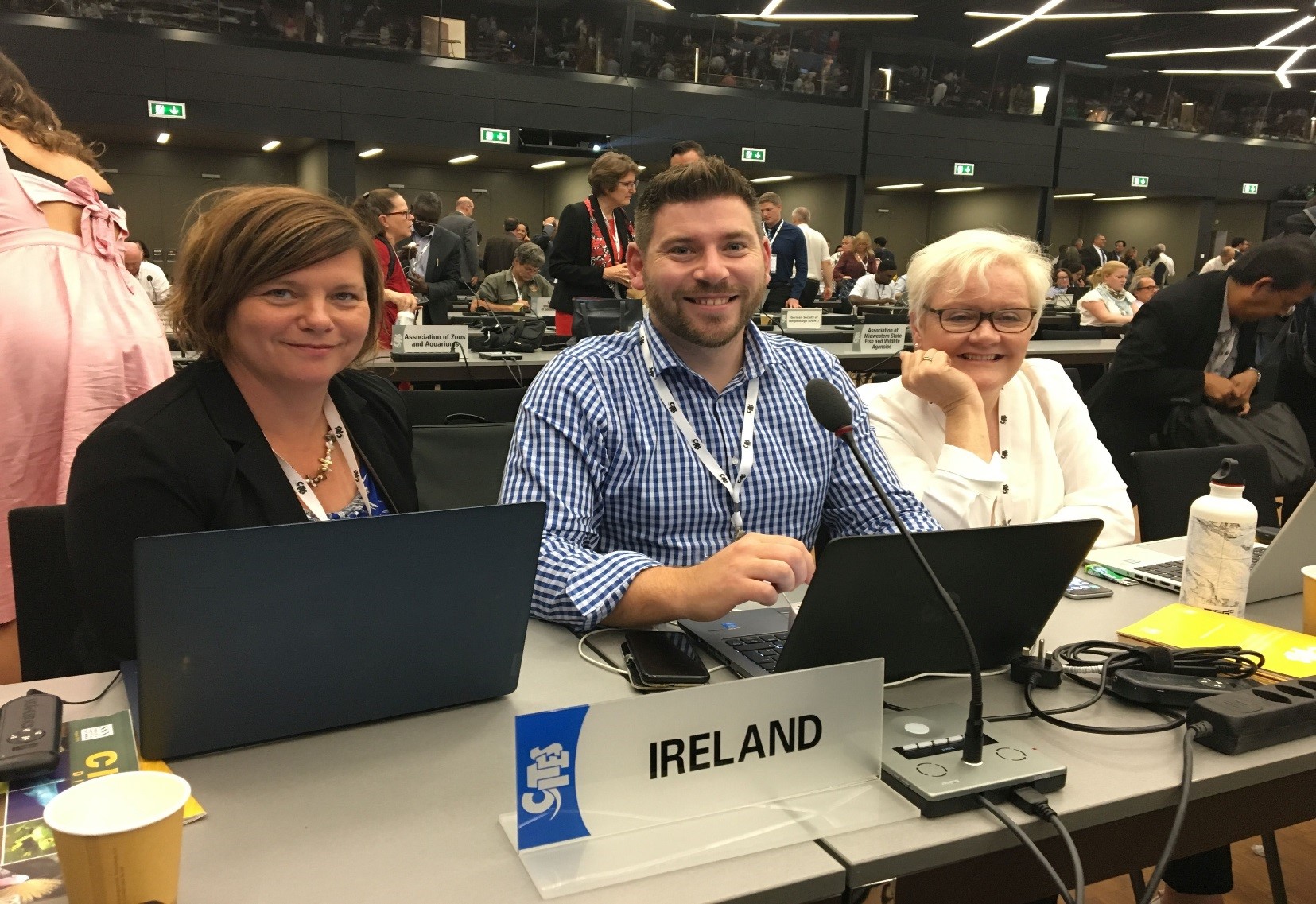
Team Ireland at work on the Ireland desk at CITES CoP 18. Right to Left Ms. Rosanna Kearns, Mr. Orlando Verrecchia (NPWS – CITES Management Authority for Ireland) and Dr Noeleen Smyth (National Botanic Gardens – CITES Scientific Authority for Ireland)
How is a species listed on CITES?
For a species to be listed on CITES a species has to meet two criteria, firstly they must be rare species and secondly they must occur in international trade. So why would we trade in such rare species you might ask? Well the answer is, well managed trade can help with both species conservation and sustainable livelihoods.
Further protection for Rosewood species
A new Rosewood species was listed on the CITES appendices for the first time, Pterocarpus tinctorius (African padauk, mukula) from Malawi. This rosewood tree species is being dramatically lost from the wild due to illegal and unsustainable logging of logs and sawn timber. Some shocking statistics were presented by Malawi in support of their proposal, stating that in Tanzanian forests, where the species also occurs, they have been disappearing at a rate of 370,000 ha per year between 2005 -2015. This is the equivalent of stripping a forest area the size of Dublin, Kildare, and Longford every year for ten years (CoP 18 Prop. 54). Musical instruments with small amounts of Rosewood were exempted from CITES controls.
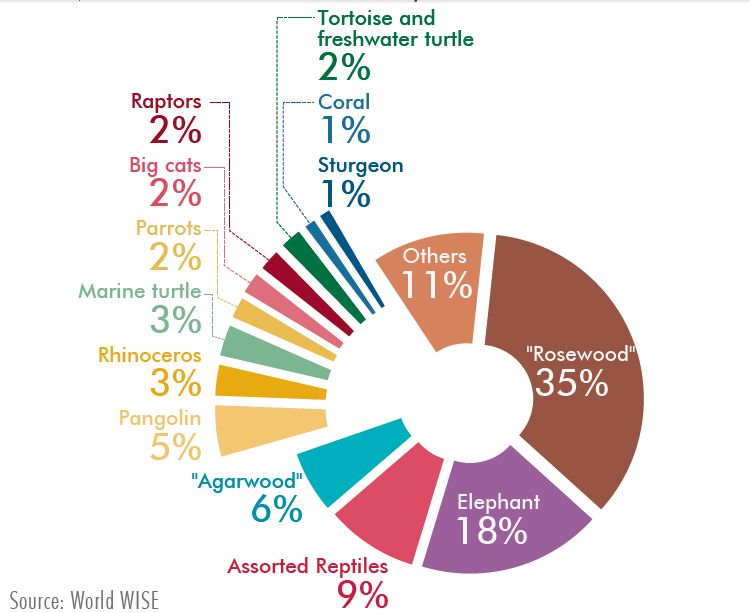
Illegal trade in Rosewood accounts for over 35% of all illegal wildlife trade (UNODC First World Wildlife Crime Report 2016)
Livelihoods and a sustainable future for Cape Aloe
Aloe ferox (Cape Aloe) has always been a popular medicinal plant in South Africa and has a long history of use. More recently, it has become part of the trend for health drinks and cosmetics around the world (CoP 18 prop 55 & Smyth et al. 2017).
At the CITES meeting the world considered the data presented forward by South Africa to exclude finished products of Aloe ferox from CITES controls and they provided data to show that when harvested correctly there is no significant impact on the species in the wild. Socio-economic challenges such as poverty and unemployment are problems in parts of South Africa and this plant provides the means of safeguarding livelihoods (CoP 18 Prop. 55).
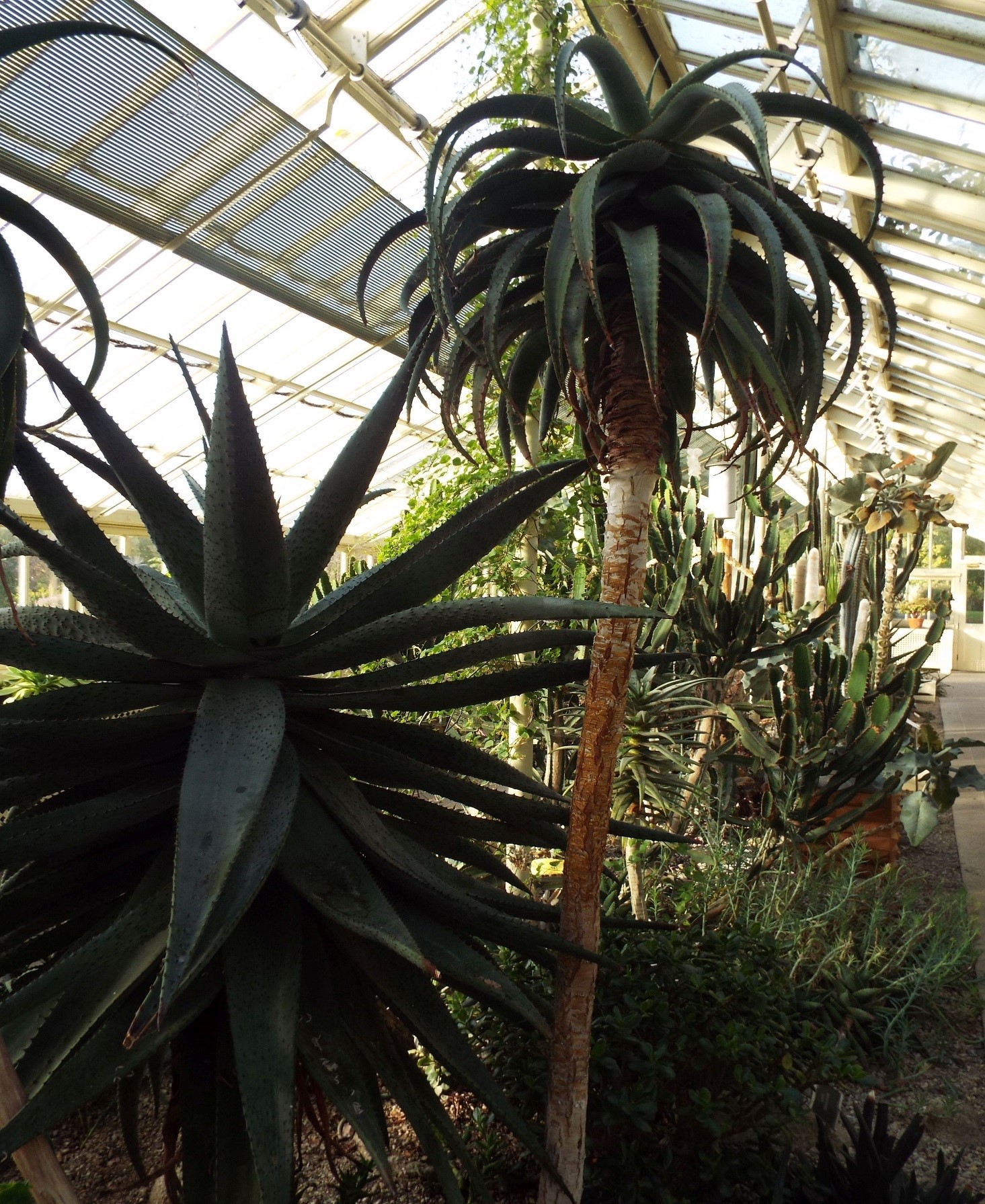
Cape Aloe (Aloe ferox) CoP18 Prop. 55 growing in the Cactus and Succulent house in the National Botanic Gardens. Finished products with Aloe ferox such as juices and creams are now exempt from CITES controls.
Decision to investigate trade and sustainability of Frankincense, one of our oldest plant products
Another of the plant groups under discussion was Boswellia spp., whose gummy sap is the source of the aromatic resin known as Frankincense, very widely used in Ireland as part of our baptism and funeral ceremonies. This resin also known as olibanum, is incorporated into a variety of products such as those for healthcare, home care, aromatherapy, cosmetics, and more recently dietary supplements. There is now increasing concern that demand and unregulated international trade are having impacts on the survival of these species in the wild.
The document submitted to the conference on trade in Boswellia spp. was submitted by Sri Lanka and the United States of America and was supported by Ireland as part of the EU and its 28 Member States (CoP 18 Doc. 66). Ireland and the other 27 Member States of the EU vote together and this forms a powerful block and alliance for global trade discussions.
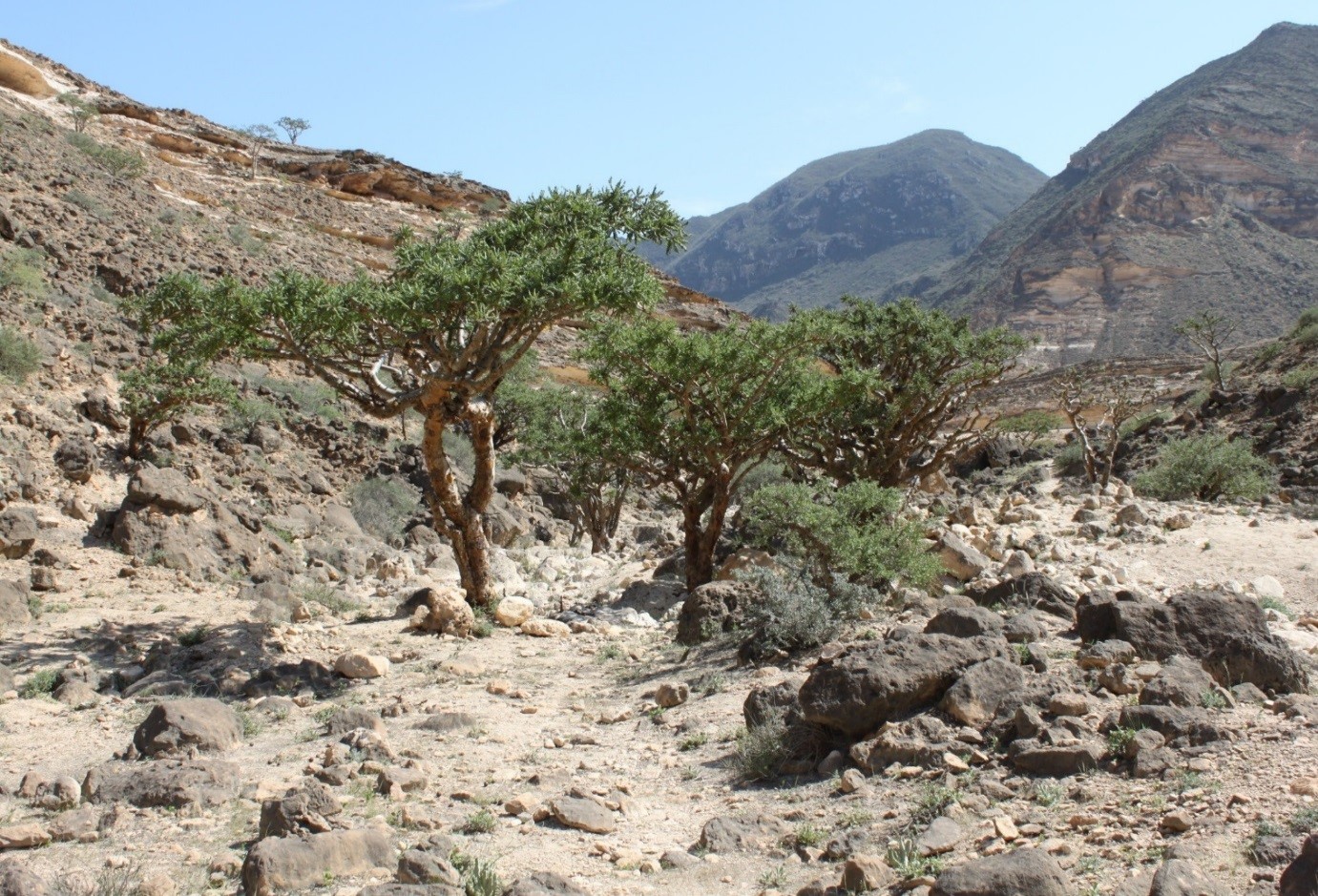
Boswellia sacra (Frankincense or olibanum-tree) CoP 18 Doc. 66. growing in Oman Rare where it is a near threatened species in the desert-woodland of Dhofar. The species extends into Yemen and Somalia. (Photo by Dr. Darach Lupton Oman Botanic Gardens). The 18th CITES CoP or World Wildlife Trade Conference agreed to investigate the impacts of trade on the species in the wild.
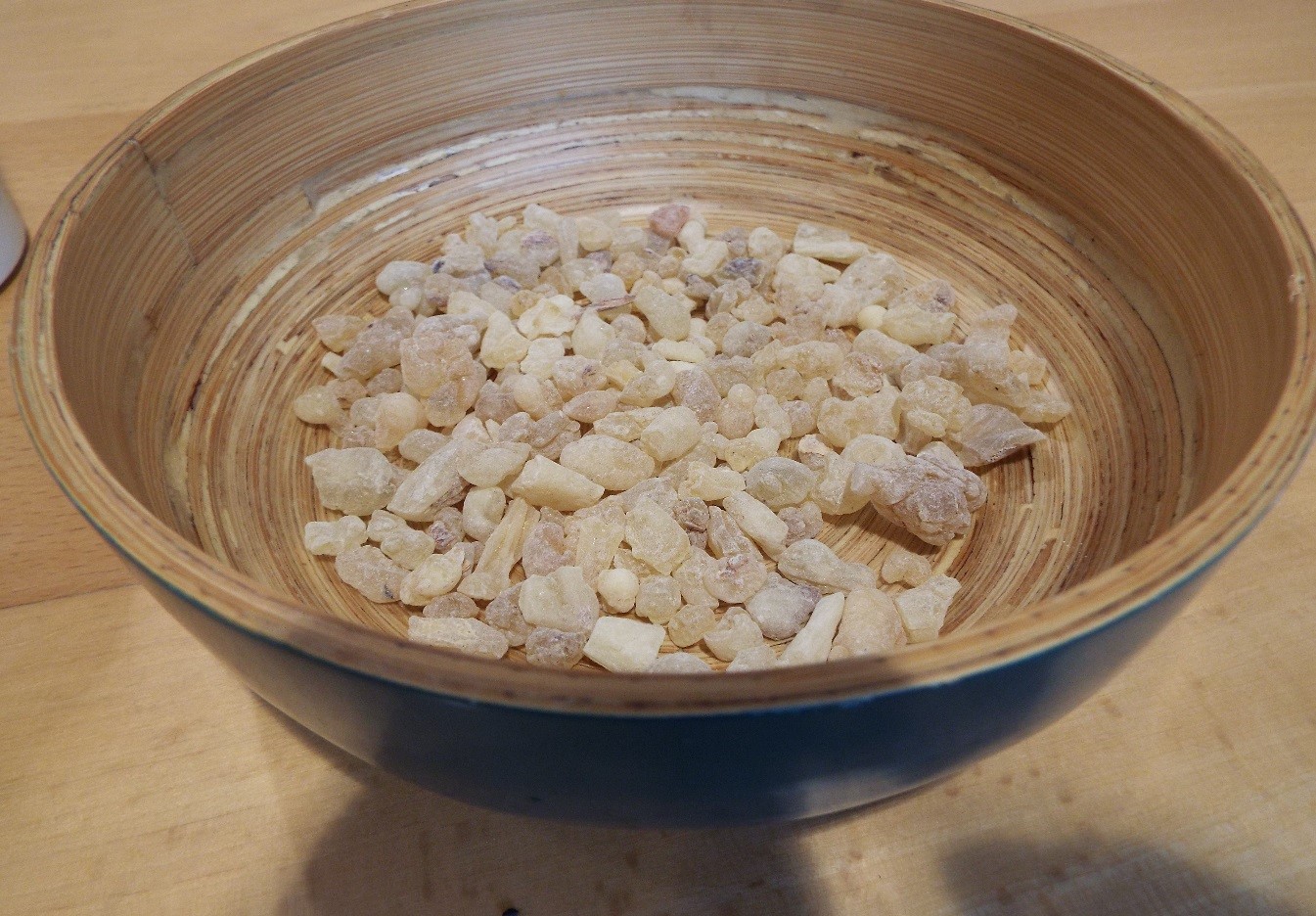
Boswellia sacra (Frankincense or olibanum resin) CoP 18 Doc. 66 now used in a large number of cosmetic and dietary products and continued to be used in religious ceremonies in baptismal oil and funeral incense.
Legal updates and trade in CITES listed plants within the EU
A surprising statistic for us is that the EU continues to import and export large quantities of wild sourced plants. The most recent EU Wildlife Trade report 2016 highlighted that of the 3,200 imported CITES taxa 2,400 of them were plants and 73 % of all CITES trade with the EU are plants. With UK plans to leave the European Union, CITES listed plant species moving from Ireland to the UK and vice versa will need CITES permits. A new EU regulation will replace the current EU CITES regulation EU 2017/160 to take account of the changes and decisions made at CITES CoP 18 and this will come into force at the end of November 2019.
Bibliography
CITES. 2019. The Convention on International Trade in Endangered species of wild fauna and flora .www.cites.org. Accessed 1st October 2019.
CoP 18 Prop 54. Pterocarpus tinctorius (African padauk, mukula) 2019. https://cites.org/sites/default/files/eng/cop/18/prop/19032019/E-CoP18-Prop-54.pdf. Accessed 1st October 2019.
CoP 18 Prop. 55. Aloe ferox (Cape Aloe) 2019 https://cites.org/sites/default/files/eng/cop/18/prop/060319/E-CoP18-Prop-55.pdf. Accessed 1st October 2019.
CoP 18 Doc. 66. Trade in Boswellia spp. 2019. https://cites.org/sites/default/files/eng/cop/18/doc/E-CoP18-066.pdf. Accessed 1st October 2019.
National Parks & Wildlife Service 2019. https://www.npws.ie/legislation/cites. Accessed 1st October 2019.
Patzelt, A. 2015. Oman Plant red Data Book. Oman Botanic Garden Publication No. 1. Al Rouya Press and Publishing House
Smyth, N., Dhanda, S., Williams, C., Cable, S., Ralimanana, Simpson, R. & Clarke, G. 2017. Plant conservation policies and international trade in Willis, K.J. (ed.) 2017. State of the World’s Plants 2017. Report. Royal Botanic Gardens, Kew. https://stateoftheworldsplants.org/2017/report/SOTWP_2017.pdf
Accessed 1st October 2019.
Thulin, M. 1998. Boswellia sacra. The IUCN Red List of Threatened Species 1998: e.T34533A9874201. http://dx.doi.org/10.2305/IUCN.UK.1998.RLTS.T34533A9874201.en. Downloaded on 01 October 2019.
UNEP-WCMC. 2018. EU Wildlife Trade 2016: Analysis of the European Union and candidate countries’ annual reports to CITES 2016.
Accessed 1st October 2019.
UNODC First World Wildlife Crime Report 2016. https://www.unodc.org/unodc/en/data-and-analysis/wildlife.html. Accessed 01 October 2019.
